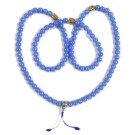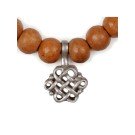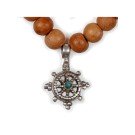Mala - Rosary Glass
The Mala is used from Hindus and Buddhists also and is a symbol of never ending cycle. A rosary with 108 pearls and 2 counters. It has to be held always in the right handwhen it is counted, when not in use it is wrapped round left wrist lie a braclet. After one circle of mantras(magic formulae) is one ring of the counter shoved above after the counter is full you take the second counter, this means one the firts counter is for the single rounds of mantras and the second counter is used for all 10 rounds.Repetition of the mantras or prayers contains the essence of formal prayer, which acts as a powerful spell. The formulae is in Sanskrit and is adressed to the deity. Different mantras are enchanted for different deities. Generally tibetan Lamas and laity chant the prayer of OM MANI PADME HUM i.e. Hail to the jewel in Lotus. It is a prayer of Avalokiteshvara .A Japa mala or mala - garland is a set of prayer beads, commonly made from 108 beads, it is used for keeping count while reciting, chanting, or mentally repeating a mantra or name/s of a deity, a practice known in Sanskrit as japa. Mantras are often repeated hundreds or even thousands of times. The mala is used so that one can think about the meaning of the mantra as it is chanted rather than thinking about counting the repetitions. One mantra is usually said for every bead, turning the thumb clockwise around each bead, though some traditions or practices may call for counterclockwise or specific finger usage. When arriving at the head bead, one turns the mala around and then goes back in the same direction. This makes using the mala easier as the beads will not be so tight on the string when you use them. If more than 108 repetitions are to be done, then sometimes in Tibetan traditions grains of rice are counted out before the chanting begins and one grain is placed in a bowl for each 108 repetitions. Each time a full mala of repetitions has been completed, one grain of rice is removed from the bowl. Often, practitioners add extra counters to their malas, usually in strings of ten. These may be positioned differently depending on the tradition; for example some traditions place these strings after every 10th bead. This is an alternative way to keep track of large numbers, sometimes going into the hundreds of thousands, and even millions. The 109th bead on a mala is called the sumeru, bindu, stupa, or guru bead. Counting should always begin with a bead next to the sumeru.
-

Mala mit Buddhaköpfen Glas blau
€24.90Incl. 19% VAT, Excl. shipping* -

Schmuckanhänger Mala Shrivasta 20 mm
€34.90Incl. 19% VAT, Excl. shipping* -

Silberschmuckanhänger Mala Dharmachakra 20 mm
€39.90Incl. 19% VAT, Excl. shipping*
* As far as not stated otherwise, all products are immidiately shippable and the prices are
€39.90
Incl. 19% VAT, Excl. shipping 
